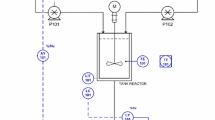Abstract
The problem of predictive modeling under condition of the nonlinearity of the mass−transfer plant (MTP) based on the experimental data is considered. To analyze the structural identifiability of the process under study and identify factors that affect the accuracy of the structural identifiability index with an unknown model structure, a technique based on an alternating conditional expectation (ACE) algorithm with a threshold value for the structural identifiability index of the MTP model is proposed. The threshold value of the structural identifiability index is determined based on the rigorous model of the plant, i.e., taking into account the physicochemical characteristics of the MTP. The proposed approach is illustrated using synthetic data and experimental data.






Similar content being viewed by others
REFERENCES
M. J. Olanrewaju, B. Huang, and A. Afacan, “Online composition estimation and experiment validation of distillation processes with switching dynamics,” Chem. Eng. Sci. 65 (5), 1597–1608 (2010).
T. Chatterjee and D. N. Saraf, “On-line estimation of product properties for crude distillation units,” J. Process Control 14, 61–77 (2004).
M. Kuhn and K. Johnson, Applied Predictive Modeling (Springer, New York, 2013).
G. B. Digo, N. B. Digo, A. V. Kozlov, S. A. Samotylova, and A. Yu. Torgashov, “Structural and parametric identification of soft sensors models for process plants based on robust regression and information criteria,” Autom. Remote Control 78 (4), 724–731 (2017).
E. Walter and L. Pronzato, “On the identifiability and distinguishability of nonlinear parametric models,” Math. Comput. Simul. 42, 125–134 (1996).
C. Cobelli and J. J. Distefano, “Parameter and structural identifiability concepts and ambiquities: A critical review and analysis,” Am. Physiol. Soc. 239 (1), 7–24 (1980).
M. J. Chappell and K. R. Godfrey, “Structural identifiability of the parameters of a nonlinear batch reactor model,” Math. Biosci. 108, 241–251 (1992).
R. Bellman and K. J. Astrom, “On structural identifiability,” Math. Biosci. 7 (3–4), 329–339 (1970).
N. Meshkat, “Identifiable reparametrizations of linear compartment models,” Symbolic Comput. 63, 46–67 (2014).
S. I. Kabanikhin, D. A. Voronov, A. A. Grodz, and O. I. Krivorotko, “Identifiability of mathematical models in medical biology,” Russ. J. Genet.: Appl. Res. 6, 838–844 (2016).
M. J. Chappell, K. R. Godfrey, and S. Vajda, “Global identifiability of the parameters of nonlinear systems with specified inputs: A comparison of methods,” Math. Biosci. 102 (1), 41–73 (1990).
S. Vajda, H. Rabitz, E. Walter, and Y. Lecourtier, “Qualitative and quantitative identifiability analysis of nonlinear chemical kinetic models,” Chem. Eng. Commun. 83, 191–219 (1989).
A. Sedoglavic, “A probabilistic algorithm to test local algebraic observability in polynomial time,” Symbolic Comput. 33, 735–755 (2002).
R. Brown, “Compartmental system analysis: State of the art,” IEEE Trans. Biomed. Eng. 27(1), 1–38 (1980).
L. Breiman and J. Friedman, “Estimating optional transformations for multiple regression and correlation,” J. Am. Stat. Assoc. 80, 580–598 (1985).
C. D. Holland, Fundamentals of Multicomponent Distillation (McGraw-Hill Book Company, New York, 1981).
D. Wang and M. Murphy, “Estimating optimal transformations for multiple regression using the ACE algorithm,” J. Data Sci. 2, 329–346 (2004).
I. S. Mozharovskii, “A method for constructing a nonparametric model based on the ACE algorithm,” in XXXII International Scientific Conference Mathematical Methods in Engineering and Technology MMTT-32 (2019), Vol. 9, pp. 39–43.
Funding
This work was partially supported by the Russian Foundation for Basic Research (project no. 17-07-00235 A).
Author information
Authors and Affiliations
Corresponding author
Rights and permissions
About this article
Cite this article
Mozharovsky, I.S., Samotylova, S.A. & Torgashov, A.Y. Predictive Modeling of Mass-Transfer of Plant Using an Algorithm of Alternating Conditional Expectations. Math Models Comput Simul 12, 915–925 (2020). https://doi.org/10.1134/S2070048220060137
Received:
Revised:
Accepted:
Published:
Issue Date:
DOI: https://doi.org/10.1134/S2070048220060137




